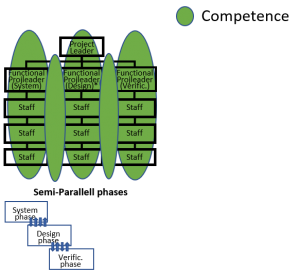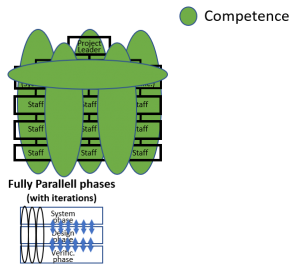In today’s blog post we will continue with semi-parallel in the same way as before, with a picture looking like this.
 Now it starts to be very different regarding the competence for the silo team members working in a project. The specification for a phase is not fully released from start of the phase. This forces the teams from different silos to learn about each other’s work to solve their common tasks. I write “their common tasks” because it is important; now we really start to be in this fight together, which means that we are going in the interdisciplinary direction. The crumbling of “this is my task and this is your task” is a necessity, since we can only solve the tasks together. This goes together with proactiveness; it is very difficult to be proactive if we do not know anything about the environment we are acting in.
Now it starts to be very different regarding the competence for the silo team members working in a project. The specification for a phase is not fully released from start of the phase. This forces the teams from different silos to learn about each other’s work to solve their common tasks. I write “their common tasks” because it is important; now we really start to be in this fight together, which means that we are going in the interdisciplinary direction. The crumbling of “this is my task and this is your task” is a necessity, since we can only solve the tasks together. This goes together with proactiveness; it is very difficult to be proactive if we do not know anything about the environment we are acting in.
When we look into the need of the market today it looks like this.
 Now it is very obvious that there are only common tasks to solve, and with a hampering of broad competence a fail is inevitable. If there is no hampering of the interactions, that is stated as one of our principles, the T-shaping will come automatically within a team and between teams when they are trying to solve their common tasks.
Now it is very obvious that there are only common tasks to solve, and with a hampering of broad competence a fail is inevitable. If there is no hampering of the interactions, that is stated as one of our principles, the T-shaping will come automatically within a team and between teams when they are trying to solve their common tasks.
Of course, we still need our respective I-competences. But, from our respective I-competence, we need to broaden our competence to T-shape, which is necessary when we are working in parallel. This is also valid in the Complex domain during our short iterations, in the form of generalists, having a small foot and very wide top of the “T”.
A football team is a good example of generalists playing in the Complex domain. They are all generalists because they all know how to play football, but they also have their position in the field as their I-competence, where they excel.
The team has different tactics depending on which team they play against, but there is no exact process how to make a goal. No one can tell from beginning how the team was going to make the goal or that they were going to, but the football commentator can in hindsight show why the team scored the goal. And the same goal can never ever be exactly repeated again.
So, everybody cannot broaden the competence in the same direction, and generally that is not a problem. Teams working together to solve their specific tasks are broadening their competence towards each other. On the other hand, there is also a total system that need to be solved and some people will get a broader competence in that direction to keep the total system together. Summarized it means that all possible shapes of the “T” is needed, which cannot be predicted, but that will emerge naturally during work.
Another important aspect that needs to be reflected on, is strategy. Earlier with Technology Push, we could in the beginning of our project, make an exact specification built on what the market needed, often communicated via our product line. But, that was then. Now, strategy also need to be part of the competence in the projects, since we many times neither know what product to do, nor how we shall do it, or if we even can do it. Without strategy + operations = true, we cannot truly state that we have an end to end development.
Tomorrow’s blog post will continue to elaborate on the necessity of broad competence. This time from the opposite direction, namely what happens when a small company becomes larger. Can you see what’s coming?

